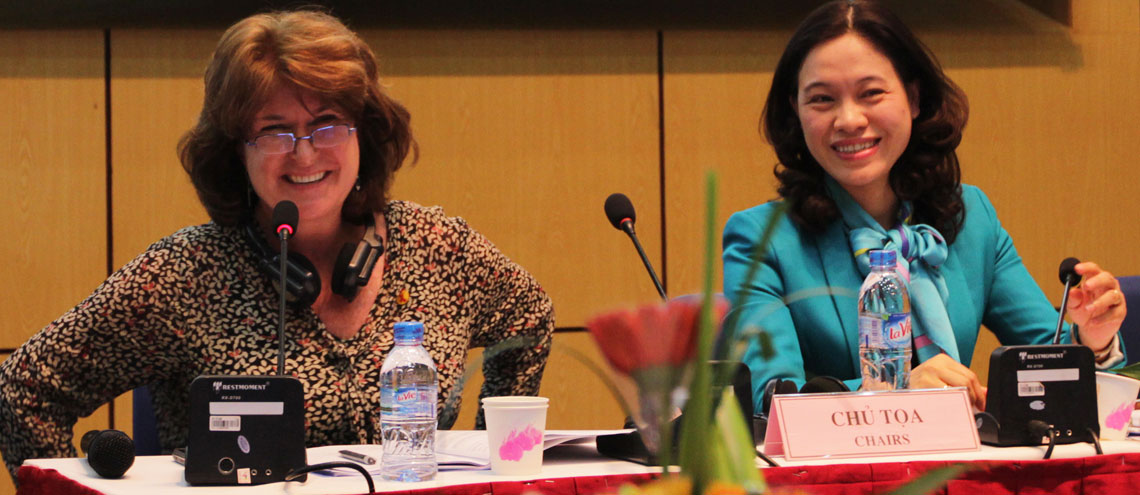More than 80 countries increase their domestic investments for AIDS by over 50% between 2006 and 2011
More than 80 countries increase their domestic investments for AIDS by over 50% between 2006 and 2011
A new report and supplement from UNAIDS shows that as international funding flattens, more countries are increasing their own share of investments for HIV and that a record 8 million people are now receiving antiretroviral therapy
HA NOI, 18 July 2012—A new report by the Joint United Nations Programme on HIV/AIDS (UNAIDS) shows that domestic funding for HIV has exceeded international investments. The report, Together we will end AIDS, states that low- and middle- income countries invested US$ 8.6 billion for the response in 2011, an increase of 11% over 2010. International funding however remained flat at 2008 levels (US$ 8.2 billion).
According to the report, 81 countries increased their domestic investments for AIDS by more than 50% between 2006 and 2011. As economies in low- and middle-income countries grow, domestic public investments for AIDS have also grown. Domestic public spending in sub-Saharan Africa for example, (not including South Africa) increased by 97% over the last five years. South Africa already spends more than 80% from domestic sources and has quadrupled its domestic investments between 2006 and 2011.
“This is an era of global solidarity and mutual accountability,” said Michel Sidibé, Executive Director of UNAIDS. “Countries most affected by the epidemic are taking ownership and demonstrating leadership in responding to HIV. However, it is not enough for international assistance to remain stable¬¬—it has to increase if we are to meet the 2015 goals.”
To further expand country ownership and support mutual accountability, the African Union launched a Roadmap for shared responsibility and global solidarity for AIDS, tuberculosis and malaria in Africa ahead of the XIX International AIDS Conference in Washington, DC. It charts a course for more diversified, balanced and sustainable financing for the AIDS response by 2015 and demonstrates Africa’s new leadership and voice in the global AIDS architecture.
BRICS countries (Brazil, Russia, India, China and South Africa) increased domestic public spending on HIV by more than 120% between 2006 and 2011. BRICS countries now fund, on average, more than 75% of their domestic AIDS responses. Domestic sources already account for more than 80% of resources spent on AIDS in South Africa and China—and the Chinese government has pledged to fully fund its response in the coming years. India, too, has committed to increase domestic funding to more than 90% in its next phase of the AIDS response. Brazil and Russia already fully fund their AIDS response with domestic resources.
HIV funding from the international community, on the other hand, has largely been stable between 2008 and 2011, at US$ 8.2 billion. Funding from the United States of America accounts for nearly 48% of all international assistance for AIDS.
“It is clear that this is no time for the world to slow down our efforts on global AIDS—rather, we must seize the moment to build on the progress we’ve made and achieve an AIDS-free generation,” said Ambassador Eric Goosby, U.S. Global AIDS Coordinator. “The United States has made it clear that we will continue to do our part in meeting our shared responsibility by making smart investments that stretch each dollar as far as possible to save lives.”
While domestic investments in AIDS are increasing, there is still a large shortfall in global funding for HIV. By 2015, the estimated annual gap will be US$ 7 billion. At the 2011 United Nations High Level Meeting on AIDS, countries adopted a Political Declaration on HIV/AIDS in which they agreed to increase investments for HIV to between US$ 22-24 billion by 2015. A concerted effort by all countries is needed to scale up funding if this target is to be met.
“Việt Nam has made significant progress with the approval of the first National Targeted Programme on HIV/AIDS, thereby increasing the state budget for HIV in 2012 by 20% compared to 2011,” said Eamonn Murphy, UNAIDS Viet Nam Country Director. “As a middle income country Viet Nam will need to continue this and further increase national resources for HIV to fill the gap created by external funding cuts in the coming years, so as to not reverse achievements made thus far.”
The report outlines that sustaining the AIDS response will require strong country ownership and global solidarity. It also emphasises the need for investments to be sustainable and predictable and that countries must be able to mobilize and use resources effectively and efficiently.
“Every dollar spent on AIDS is an investment, not an expenditure,” said Mr Sidibé. “We need to focus not only on achieving the 2015 targets but we need to look beyond and keep our sights set firmly on realizing our vision of zero new HIV infections, zero discrimination and zero AIDS-related deaths.”
[END]
UNAIDS Contacts
Geneva | Saira Stewart | tel. +41 22 791 2511 | stewarts@unaids.org
Washington DC | Sophie Barton-Knott | tel. +1 202 735 46 05 | bartonknotts@unaids.org
Ha Noi | Nguyen Thi Bich Hue | tel. 0984 259 523 | bichhuen@unaids.org
UNAIDS
The Joint United Nations Programme on HIV/AIDS (UNAIDS) leads and inspires the world to achieve its shared vision of zero new HIV infections, zero discrimination and zero AIDS-related deaths. UNAIDS unites the efforts of 11 UN organizations—UNHCR, UNICEF, WFP, UNDP, UNFPA, UNODC, UN Women, ILO, UNESCO, WHO and the World Bank—and works closely with global and national partners to maximize results for the AIDS response. Learn more at unaids.org and connect with us on Facebook and Twitter




